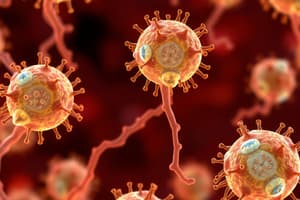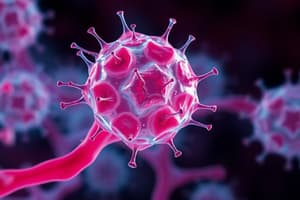Podcast
Questions and Answers
What is primarily lost in vital organs as a result of aging?
What is primarily lost in vital organs as a result of aging?
- Functional capacity (correct)
- Nutritional absorption
- Cellular volume
- Structural integrity
Which of the following statements about stem cell changes with age is accurate?
Which of the following statements about stem cell changes with age is accurate?
- All types of stem cells show equivalent growth with aging.
- There is an increase in the number and functionality of stem cells.
- Only the number of functional stem cells declines.
- Stem cells accumulate mutations, affecting their function. (correct)
What physical change is NOT typically associated with aging?
What physical change is NOT typically associated with aging?
- Height increase (correct)
- Increased inflammation
- Presence of wrinkles
- Weight gain
How does the repair capacity of tissues change with age?
How does the repair capacity of tissues change with age?
Which of the following is a consequence of changes in tissue properties with aging?
Which of the following is a consequence of changes in tissue properties with aging?
During which life stage is stem cell activity typically at its highest?
During which life stage is stem cell activity typically at its highest?
What is a common disease risk associated with aging?
What is a common disease risk associated with aging?
What is one significant outcome of calorie restriction observed in rats compared to those on a normal diet?
What is one significant outcome of calorie restriction observed in rats compared to those on a normal diet?
Which cellular function is restored by calorie restriction according to the findings?
Which cellular function is restored by calorie restriction according to the findings?
What role does Wnt signaling play in aging as indicated in the findings?
What role does Wnt signaling play in aging as indicated in the findings?
In the context of calorie restriction, what effect does it have on inflammation with age?
In the context of calorie restriction, what effect does it have on inflammation with age?
What method was primarily used in the study to analyze tissue composition in the research on calorie restriction?
What method was primarily used in the study to analyze tissue composition in the research on calorie restriction?
What is a key outcome of aging on the functionality of hematopoietic stem cells?
What is a key outcome of aging on the functionality of hematopoietic stem cells?
Which intrinsic mechanism primarily contributes to the functional deterioration of stem cells with age?
Which intrinsic mechanism primarily contributes to the functional deterioration of stem cells with age?
How does the diversity of skin stem cells change with aging?
How does the diversity of skin stem cells change with aging?
Which factor is associated with changes in cellular metabolic processes in aging stem cells?
Which factor is associated with changes in cellular metabolic processes in aging stem cells?
What happens to mitochondrial efficiency in stem cells as they age?
What happens to mitochondrial efficiency in stem cells as they age?
Which of the following represents a common misconception about aging stem cells?
Which of the following represents a common misconception about aging stem cells?
Which of these statements accurately describes the evolutionary perspective on post-reproductive age stem cell activity?
Which of these statements accurately describes the evolutionary perspective on post-reproductive age stem cell activity?
What age-related change occurs in the variety of active hematopoietic stem cells?
What age-related change occurs in the variety of active hematopoietic stem cells?
Which epigenetic change is commonly associated with aging in stem cells?
Which epigenetic change is commonly associated with aging in stem cells?
How does age affect spermatogonial stem cells according to the findings?
How does age affect spermatogonial stem cells according to the findings?
What key finding resulted from the transplantation experiment involving aging spermatogonial stem cells?
What key finding resulted from the transplantation experiment involving aging spermatogonial stem cells?
What does parabiosis surgery reveal about systemic factors in aging?
What does parabiosis surgery reveal about systemic factors in aging?
What were the observed effects on muscle regeneration in old and young mice?
What were the observed effects on muscle regeneration in old and young mice?
What conclusion can be drawn regarding the intrinsic changes in stem cells with age?
What conclusion can be drawn regarding the intrinsic changes in stem cells with age?
In what way can systemic aging influences be demonstrated?
In what way can systemic aging influences be demonstrated?
What is indicated by the phrase 'systemic factors' in relation to aging?
What is indicated by the phrase 'systemic factors' in relation to aging?
What aspect of stem cell function is primarily controlled by the aging process?
What aspect of stem cell function is primarily controlled by the aging process?
Which statement accurately reflects the relationship between systemic factors and muscle regeneration?
Which statement accurately reflects the relationship between systemic factors and muscle regeneration?
What is the primary purpose of transplanting young stem cells into old mice during experiments?
What is the primary purpose of transplanting young stem cells into old mice during experiments?
In the context of parabiosis experiments, what is the significance of pairing young and old mice?
In the context of parabiosis experiments, what is the significance of pairing young and old mice?
What role does the stiffness of the tissue extracellular matrix play in stem cell behavior?
What role does the stiffness of the tissue extracellular matrix play in stem cell behavior?
Which observation would suggest that an aging phenotype is influenced by a dysfunctional microenvironment?
Which observation would suggest that an aging phenotype is influenced by a dysfunctional microenvironment?
What is a key factor in determining whether niche microenvironment influences stem cell activity?
What is a key factor in determining whether niche microenvironment influences stem cell activity?
Which type of stem cells should be used when assessing the impact of the microenvironment through transplantation?
Which type of stem cells should be used when assessing the impact of the microenvironment through transplantation?
What does the term 'systemic factors' refer to in the context of stem cell behavior?
What does the term 'systemic factors' refer to in the context of stem cell behavior?
What is a potential outcome of transplantation experiments using old stem cells into young mice?
What is a potential outcome of transplantation experiments using old stem cells into young mice?
Which experimental design is utilized to ascertain whether the local niche impacts stem cell behavior?
Which experimental design is utilized to ascertain whether the local niche impacts stem cell behavior?
What might indicate that systemic factors do not affect stem cell behavior?
What might indicate that systemic factors do not affect stem cell behavior?
Flashcards
Vital Organ Decline
Vital Organ Decline
A decline in the functioning of vital organs, such as the heart, with age.
Increased Susceptibility to Diseases
Increased Susceptibility to Diseases
An increase in the risk of developing various illnesses, including cancer and chronic diseases like diabetes, as we get older.
Changes in Tissue Properties
Changes in Tissue Properties
Changes in the physical properties of tissues, including increased tightness or stiffness (e.g., in skin) or the formation of scar tissue (fibrosis).
Reduced Repair Capacity
Reduced Repair Capacity
Signup and view all the flashcards
Loss of Tissue Mass
Loss of Tissue Mass
Signup and view all the flashcards
Decline in Stem Cell Numbers
Decline in Stem Cell Numbers
Signup and view all the flashcards
Functional Decline of Stem Cells
Functional Decline of Stem Cells
Signup and view all the flashcards
Stem cell activity in reproductive years
Stem cell activity in reproductive years
Signup and view all the flashcards
Stem cell activity in protected aging phase
Stem cell activity in protected aging phase
Signup and view all the flashcards
Evolutionary perspective on stem cell decline
Evolutionary perspective on stem cell decline
Signup and view all the flashcards
Changes in blood stem cells with age
Changes in blood stem cells with age
Signup and view all the flashcards
Changes in Skin stem cells with age
Changes in Skin stem cells with age
Signup and view all the flashcards
DNA damage and telomere shortening in stem cell aging
DNA damage and telomere shortening in stem cell aging
Signup and view all the flashcards
Mitochondrial dysfunction in stem cell aging
Mitochondrial dysfunction in stem cell aging
Signup and view all the flashcards
Epigenetic alterations in stem cell aging
Epigenetic alterations in stem cell aging
Signup and view all the flashcards
Metabolic changes in stem cell aging
Metabolic changes in stem cell aging
Signup and view all the flashcards
Testing Microenvironment Influence
Testing Microenvironment Influence
Signup and view all the flashcards
Testing Microenvironment's Role in Regeneration
Testing Microenvironment's Role in Regeneration
Signup and view all the flashcards
Parabiosis
Parabiosis
Signup and view all the flashcards
Young-Young Parabiosis
Young-Young Parabiosis
Signup and view all the flashcards
Old-Old Parabiosis
Old-Old Parabiosis
Signup and view all the flashcards
Young-Old Parabiosis
Young-Old Parabiosis
Signup and view all the flashcards
Stem Cell Division and Aging
Stem Cell Division and Aging
Signup and view all the flashcards
Stem Cell Differentiation and Aging
Stem Cell Differentiation and Aging
Signup and view all the flashcards
Stem Cell Repair and Aging
Stem Cell Repair and Aging
Signup and view all the flashcards
Niche Microenvironment
Niche Microenvironment
Signup and view all the flashcards
What is Calorie Restriction?
What is Calorie Restriction?
Signup and view all the flashcards
How does Calorie Restriction Affect Senescence?
How does Calorie Restriction Affect Senescence?
Signup and view all the flashcards
What is the Impact of Calorie Restriction on Inflammation?
What is the Impact of Calorie Restriction on Inflammation?
Signup and view all the flashcards
How does Calorie Restriction Affect Cell Communication?
How does Calorie Restriction Affect Cell Communication?
Signup and view all the flashcards
What are the Molecular Changes with Calorie Restriction?
What are the Molecular Changes with Calorie Restriction?
Signup and view all the flashcards
Age-Related Decline in Spermatogonial Stem Cells
Age-Related Decline in Spermatogonial Stem Cells
Signup and view all the flashcards
Stem Cell Niche
Stem Cell Niche
Signup and view all the flashcards
Tissue Regeneration
Tissue Regeneration
Signup and view all the flashcards
Stem Cell Aging
Stem Cell Aging
Signup and view all the flashcards
Systemic Factors and Rejuvenation
Systemic Factors and Rejuvenation
Signup and view all the flashcards
Niche Influence on Stem Cell Aging
Niche Influence on Stem Cell Aging
Signup and view all the flashcards
Stem Cell Transplant and Rejuvenation
Stem Cell Transplant and Rejuvenation
Signup and view all the flashcards
Intrinsic vs. Extrinsic Factors in Stem Cell Aging
Intrinsic vs. Extrinsic Factors in Stem Cell Aging
Signup and view all the flashcards
Muscle Regeneration and Aging
Muscle Regeneration and Aging
Signup and view all the flashcards
Study Notes
Lecture 19: Stem Cell Ageing and Strategies for Rejuvenation
- Population Ageing: By 2061, the proportion of Australians aged 65+ is projected to increase from 14.0% to 22.4%.
- Age and Tissue Decline: Age is associated with a reduced ability of tissues to maintain and regenerate, leading to various changes like organ decline.
- Organ Decline: Nearly all vital organs experience functional decline with age. Cardiac failure is a significant cause of death related to this.
- Susceptibility to Diseases: The risk of cancer increases with age, as does the incidence of chronic diseases like diabetes.
- Tissue Stiffness: Some connective tissues lose elasticity (e.g., skin), while others become stiff, showing fibrosis.
- Reduced Repair Capacity: Wound healing and repair processes become slower as we age. Damage to the gastrointestinal tract is a concern.
- Tissue Mass Loss: Muscle mass decreases significantly with age.
- Physical Changes: Age is associated with wrinkles, gray hair, and weight gain. Inflammation increases.
- Stem Cell Decline and Mutations: Stem cells decline in many tissues with age and accumulate mutations, which impact their function.
- Stem Cell Numbers Change: Some tissues show a reduction in stem cell numbers as we age, while others experience an increase, though with reduced functionality.
- Stem Cell Activity Throughout Life: Stem cell activity varies throughout the lifespan, following a natural decline post-reproductive years.
Mechanisms Underlying Stem Cell Deterioration
- DNA Damage and Telomere Shortening: Accumulation of DNA damage and shortening of telomeres contribute to cellular senescence.
- Mitochondrial Dysfunction: Reduced mitochondrial efficiency with age.
- Epigenetic Alterations: Age-associated changes in epigenetic markers.
- Metabolic Changes: Alterations in cellular metabolic processes in stem cells.
- Systemic or Circulatory Factors: Influence of the circulatory system on stem cell behavior.
- Local Niche Microenvironment Growth Signals: Role of growth factors and signals from adjacent cells in regulating stem cell activity.
- Tissue Extracellular Matrix Stiffness: Increased tissue stiffness (fibrosis) affects stem cell function/behavior.
Testing Stem Cell Dynamics
- Testing Niche Microenvironment: Transplanting young stem cells into both young and old mice. If the stem cell function declines in the older mouse, the decline is due to niche-related factors. Conversely, old stem cells in a young mouse environment demonstrate niche effects on aging phenotype.
- Testing Systemic Effects: Parabiosis experiments connecting the blood supply of young and old mice examined if systemic features affect the phenotype of aged stem cells.
Effects of Age on Specific Tissues
- Spermatogonial Stem Cells: Reduced number of functional stem cells in the testes as age increases.
- Muscle Stem Cells: Decreased number and function, as well as changes in differentiation toward a fibroblast-like lineage. This leads to fibrosis.
- Other tissues: Decreased neurogenesis and angiogenesis in the brain; downregulation of hepatocyte proliferation.
Factors That Promote Aging Reversal
- GDF-11 (Growth Differentiation Factor 11): When supplied to older mice, it increases muscle function and enhances tissue regeneration.
- CCL-11: Upregulated in older, inhibits muscle function and regeneration.
Stem Cell Intrinsic Defects
- Proteasome System Breakdown: Reduction in ubiquitin-proteasome system activity leads to toxic protein aggregates.
- Unfolded Protein Response (UPR) Downregulation: Reduced ability to handle misfolded proteins.
- Mitochondrial Damage: Mitochondria dysfunction often accompanied by DNA mutations affects energy generation.
- Increased Reactive Oxygen Species (ROS): Increased ROS production due to protein aggregates and mitochondrial damage contributes to DNA damage and increased mutation rates.
Hematopoietic Stem Cell (HSC) Decline
- Diversity Decline: Diversity in HSCs decreases with age.
- Functional Decline: The number of active functional HSCs declines.
- Skewed Differentiation Increased production of myeloid cells compared to lymphoid cells (imbalance in blood cell types).
- Altered Niche Signals: Changes in signaling molecules in the HSC niche affect age-related changes.
Caloric Restriction
- Calorie Restriction and Lifespan: Lower calorie diets are linked with increased lifespan.
- Effects on Senescence: Calorie restriction has shown reduced senescence markers.
- Cellular Communication/Inflammation: Reduced inflammation associated with the aging process.
- Effects on Metabolism: Calorie restriction alters metabolic pathways affecting cellular function.
Strategies to Reverse Aging
- Modulating Metabolism: Targeting mitochondrial function and increasing NAD availability.
Studying That Suits You
Use AI to generate personalized quizzes and flashcards to suit your learning preferences.




